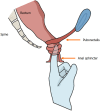Enhancing clinical practice: The role of digital rectal examination in diagnosing functional defecation disorders
- PMID: 40740891
- PMCID: PMC12305291
- DOI: 10.4240/wjgs.v17.i7.106471
Enhancing clinical practice: The role of digital rectal examination in diagnosing functional defecation disorders
Abstract
Digital rectal examination (DRE) is essential for diagnosing anorectal diseases, yet its widespread adoption remains suboptimal among practitioners. While modalities such as anorectal manometry, rectal balloon expulsion tests, pelvic floor electromyography, and dynamic imaging (defecography/pelvic floor magnetic resonance imaging) enable comprehensive assessment of anorectal function, many healthcare facilities lack advanced diagnostic tools and specialized personnel. DRE has notable diagnostic value in the primary evaluation of functional defecation disorders (FDDs), particularly for detecting dyssynergic defecation and structural pelvic floor defects. Its cost efficiency and universal accessibility render it indispensable in resource-limited environments where high-resolution diagnostic technologies (e.g., high-resolution manometry) are unavailable. This review delineates standardized DRE protocols for assessing FDDs and highlights characteristic imaging features of FDDs with the aim of improving the understanding of DRE. This review will hopefully encourage clinicians to perform DREs in diverse clinical settings.
Keywords: Constipation; Digital rectal examination; Dyssynergic defecation; Functional defecation disorders; Review.
©The Author(s) 2025. Published by Baishideng Publishing Group Inc. All rights reserved.
Conflict of interest statement
Conflict-of-interest statement: The authors declare that they have no conflict of interest.
Figures




Similar articles
-
Integrating anorectal manometry, balloon expulsion, and defecography: insights into diagnosing pelvic floor dysfunction.Am J Physiol Gastrointest Liver Physiol. 2025 Aug 1;329(2):G270-G275. doi: 10.1152/ajpgi.00100.2025. Epub 2025 Jun 26. Am J Physiol Gastrointest Liver Physiol. 2025. PMID: 40569575
-
To what extent are anorectal function tests comparable? A study comparing digital rectal examination, anal electromyography, 3-dimensional high-resolution anal manometry, and transperineal ultrasound.Int J Colorectal Dis. 2023 Jan 16;38(1):12. doi: 10.1007/s00384-022-04304-6. Int J Colorectal Dis. 2023. PMID: 36645523 Free PMC article.
-
AGA Clinical Practice Update on GI Manifestations and Autonomic or Immune Dysfunction in Hypermobile Ehlers-Danlos Syndrome: Expert Review.Clin Gastroenterol Hepatol. 2025 Jul;23(8):1291-1302. doi: 10.1016/j.cgh.2025.02.015. Epub 2025 May 19. Clin Gastroenterol Hepatol. 2025. PMID: 40387691 Review.
-
Dyssynergic Defecation: A Comprehensive Review on Diagnosis and Management.Turk J Gastroenterol. 2023 Mar;34(3):182-195. doi: 10.5152/tjg.2023.22148. Turk J Gastroenterol. 2023. PMID: 36919830 Free PMC article. Review.
-
Imaging modalities for the detection of posterior pelvic floor disorders in women with obstructed defaecation syndrome.Cochrane Database Syst Rev. 2021 Sep 23;9(9):CD011482. doi: 10.1002/14651858.CD011482.pub2. Cochrane Database Syst Rev. 2021. PMID: 34553773 Free PMC article.
References
-
- Barberio B, Judge C, Savarino EV, Ford AC. Global prevalence of functional constipation according to the Rome criteria: a systematic review and meta-analysis. Lancet Gastroenterol Hepatol. 2021;6:638–648. - PubMed
-
- Salari N, Ghasemianrad M, Ammari-Allahyari M, Rasoulpoor S, Shohaimi S, Mohammadi M. Global prevalence of constipation in older adults: a systematic review and meta-analysis. Wien Klin Wochenschr. 2023;135:389–398. - PubMed
-
- Hayat U, Dugum M, Garg S. Chronic constipation: Update on management. Cleve Clin J Med. 2017;84:397–408. - PubMed
-
- Lucak S, Lunsford TN, Harris LA. Evaluation and Treatment of Constipation in the Geriatric Population. Clin Geriatr Med. 2021;37:85–102. - PubMed
Publication types
LinkOut - more resources
Full Text Sources

